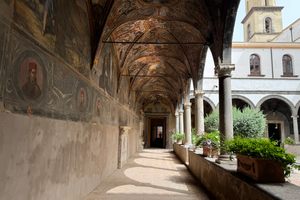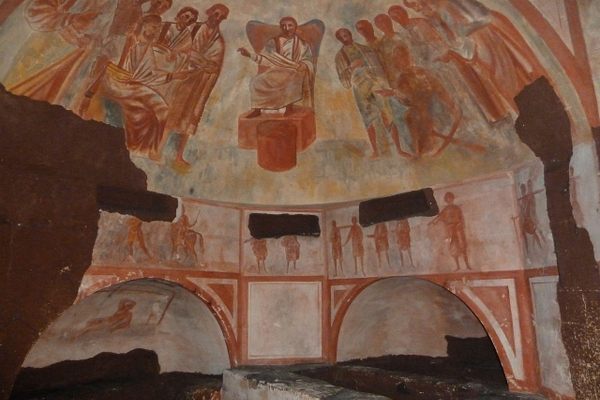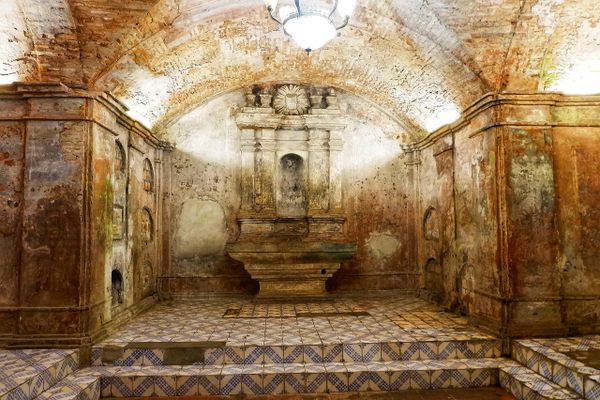About
In the 430s CE, a Tunisian bishop named Septimius Celius Gaudiosus, along with several other of his ecclesiastical colleagues, was unceremoniously set adrift in the Mediterranean on a ship without oars by the Vandal king Genseric, who had just conquered Roman North Africa. The ascendant king's beef with the bishop was due to the latter's refusal to convert to the heretical Arian faith practiced by the Vandals.
Lack of oars notwithstanding, Gaudiosus made his way north to Naples, where he founded a monastery, introduced the Rule of Augustine (a fellow African saint) to Italy, and, according to tradition, was buried, along with other 5th-century African refugees, in the Greek-era catacombs located in what is now the city's Sanità district.
Throughout late Antiquity and the early Middle Ages, the catacombs came to be decorated with some of the oldest surviving Christian art, simple representations of grapes, fish, lamb, candles, and images of the Apostles. The Campania region's earliest known depiction of the Virgin Mary was painted in a small chapel, now part of the underground complex, built alongside the tombs for pilgrims and worshippers (it was moved and is now venerated in the nearby basilica of Santa Maria della Sanità).
Thanks to recurring problems with landslides and theft, the complex was shuttered by the end of the medieval age. Many of the catacombs' tunnels were gradually filled by the landslides. Theft of ancient tombs was rampant during the tumultuous Middle Ages—the Neapolitans became protective of their sundry holy possessions after the catacombs of Saint Januarius, Naples' most important saint, were robbed of their patron's relics in the 9th century by the prince of rival city Benevento. After this, the neighboring Catacombs of Saint Gaudiosus were sealed within the walls of the city and slowly forgotten.
Fast-forward to the late 16th century. The basilica of Santa Maria della Sanità was built adjacent to the site of the abandoned catacombs, which were most recently being used as a farm cellar. The Dominican Order that administrated the church excavated the tombs and quickly reappropriated them as a venue for their macabre style of bodily preservation and display. Using the catacomb complex, the monks perfected a mummification process that was highly desired by the wealthy elite of 17th-century Naples, one that had the added bonus of lining the order's pockets.
In the first step of the process, the corpse was placed in a niche carved into the tomb wall. Holes were then strategically carved into the body—its fluids were slowly drained over a year. Finally, the preserved reamins were displayed along the walls of the catacombs. The body itself was plastered over; in its place, the person was depicted as a skeleton in a fresco that connected to the head sticking out of the wall.
The result is an extreme form of memento mori, which highlights of the Dominicans' interest in the head as the center of thought, and thus, the source of knowledge of the divine. Burial in the head-lined tomb complex was so coveted that one of the frescos' painters, Giovanni Balducci, refused payment for his work, accepting instead burial alongside the aristocracy in the catacombs.
The unsurprising hygienic problems resulting from the catacombs' packing of decaying corpses in a damp, closed area eventually led to the Dominicans' abandonment of the preservation practice by the end of the 17th century. Many remains were eventually transferred to nearby cemeteries in the ensuing centuries. Until recently very few knew of the catacombs' hidden existence in the bustling working class Sanità neighborhood. A local cooperative of archaeologists and art historians began to excavate and give tours of the complex in 2006.
Related Tags
Know Before You Go
Access to the catacombs is available via the tour given by Cooperativa La Paranza. The tours are given in Italian and English, every day of the week, between 10 a.m. and 1 p.m.
Flavors of Italy: Roman Carbonara, Florentine Steak & Venetian Cocktails
Savor local cuisine across Rome, Florence & Venice.
Book NowPublished
May 16, 2018
Sources
- http://www.catacombedinapoli.it/en/places/catacombs-of-san-gaudioso-naples
- https://it.wikipedia.org/wiki/Catacombe_di_San_Gaudioso
- https://it.wikipedia.org/wiki/Rione_Sanità
- https://archive.org/stream/in.ernet.dli.2015.283866/2015.283866.The-Western_djvu.txt
- http://www.catacombedinapoli.it/en/places/catacombs-of-san-gaudioso-naples
- https://it.wikipedia.org/wiki/Catacombe_di_San_Gaudioso
- https://it.wikipedia.org/wiki/Rione_Sanità
- https://archive.org/stream/in.ernet.dli.2015.283866/2015.283866.The-Western_djvu.txt


















































